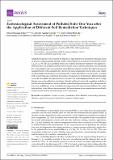Por favor, use este identificador para citar o enlazar a este item:
http://hdl.handle.net/10261/308029COMPARTIR / EXPORTAR:
 SHARE SHARE
 CORE
BASE CORE
BASE
|
|
| Visualizar otros formatos: MARC | Dublin Core | RDF | ORE | MODS | METS | DIDL | DATACITE | |

| Título: | Ecotoxicological assessment of polluted soils one year after the application of different soil remediation techniques |
Autor: | Paniagua-López, M. CSIC ORCID; Aguilar-Garrido, A.; Contero-Hurtado, José; García-Romera, Inmaculada CSIC; Sierra-Aragón, M.; Romero-Freire, Ana CSIC ORCID | Palabras clave: | Soil pollution Circular economy Remediation Bioavailability Ecotoxicology Bioassay Hordeum vulgare Lactuca sativa Raphidocelis subcapitata Daphnia magna |
Fecha de publicación: | mar-2023 | Editor: | Multidisciplinary Digital Publishing Institute | Citación: | Toxics 11(4): 298 (2023) | Resumen: | The present work evaluated the influence of eight different soil remediation techniques, based on the use of residual materials (gypsum, marble, vermicompost) on the reduction in metal(loid)s toxicity (Cu, Zn, As, Pb and Cd) in a polluted natural area. Selected remediation treatments were applied in a field exposed to real conditions and they were evaluated one year after the application. More specifically, five ecotoxicological tests were carried out using different organisms on either the solid or the aqueous (leachate) fraction of the amended soils. Likewise, the main soil properties and the total, water-soluble and bioavailable metal fractions were determined to evaluate their influence on soil toxicity. According to the toxicity bioassays performed, the response of organisms to the treatments differed depending on whether the solid or the aqueous fraction was used. Our results highlighted that the use of a single bioassay may not be sufficient as an indicator of toxicity pathways to select soil remediation methods, so that the joint determination of metal availability and ecotoxicological response will be determinant for the correct establishment of any remediation technique carried out under natural conditions. Our results indicated that, of the different treatments used, the best technique for the remediation of metal(loid)s toxicity was the addition of marble sludge with vermicompost. | Versión del editor: | https://doi.org/10.3390/toxics11040298 | URI: | http://hdl.handle.net/10261/308029 | DOI: | 10.3390/toxics11040298 | E-ISSN: | 2305-6304 | Identificadores: | doi: 10.3390/toxics11040298 |
| Aparece en las colecciones: | (EEZ) Artículos |
Ficheros en este ítem:
| Fichero | Descripción | Tamaño | Formato | |
|---|---|---|---|---|
| toxics-11-00298-v2.pdf | 1,51 MB | Adobe PDF |  Visualizar/Abrir |
CORE Recommender
SCOPUSTM
Citations
3
checked on 17-may-2024
WEB OF SCIENCETM
Citations
3
checked on 26-feb-2024
Page view(s)
37
checked on 18-may-2024
Download(s)
33
checked on 18-may-2024
Google ScholarTM
Check
Altmetric
Altmetric
Este item está licenciado bajo una Licencia Creative Commons

